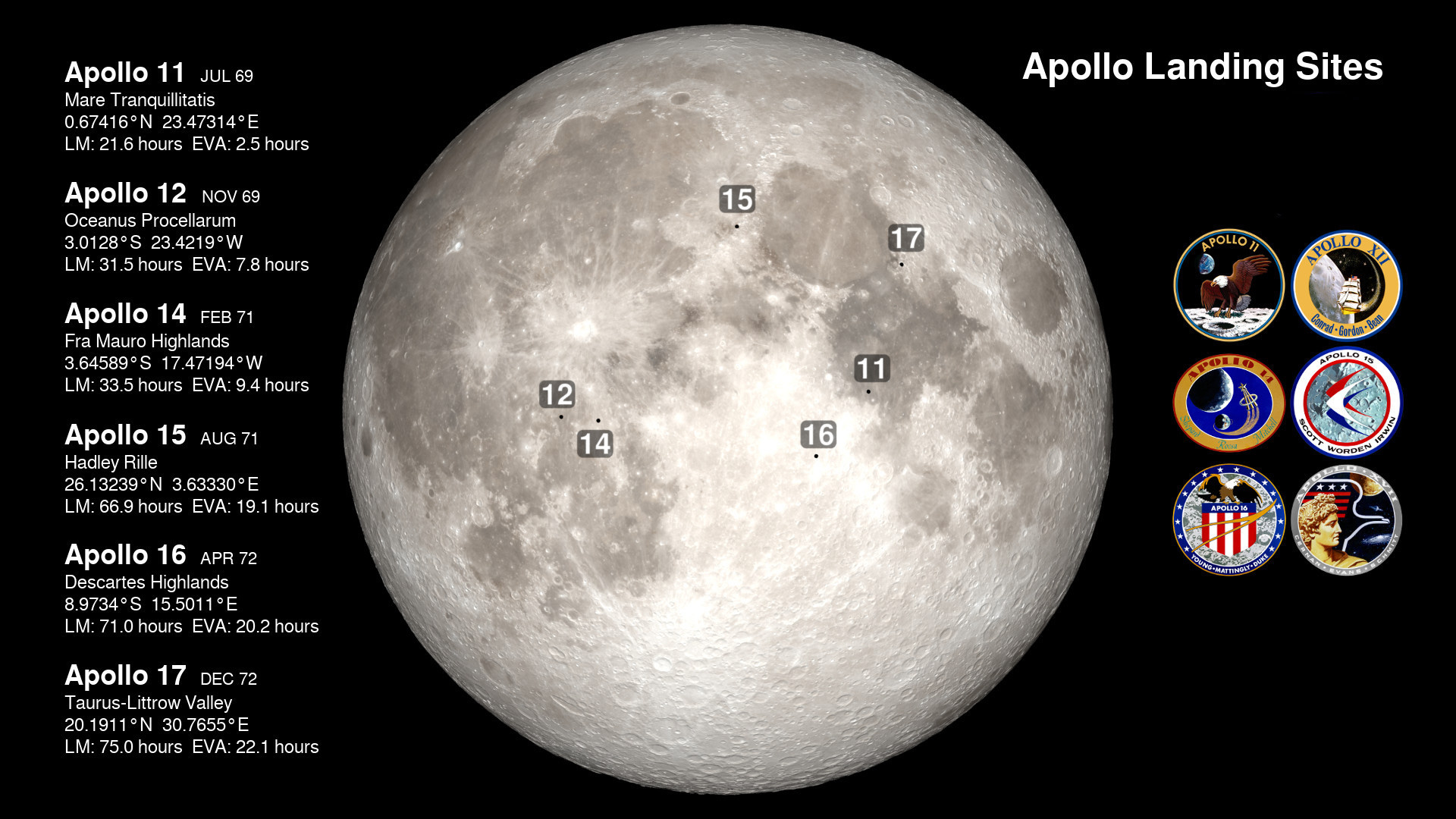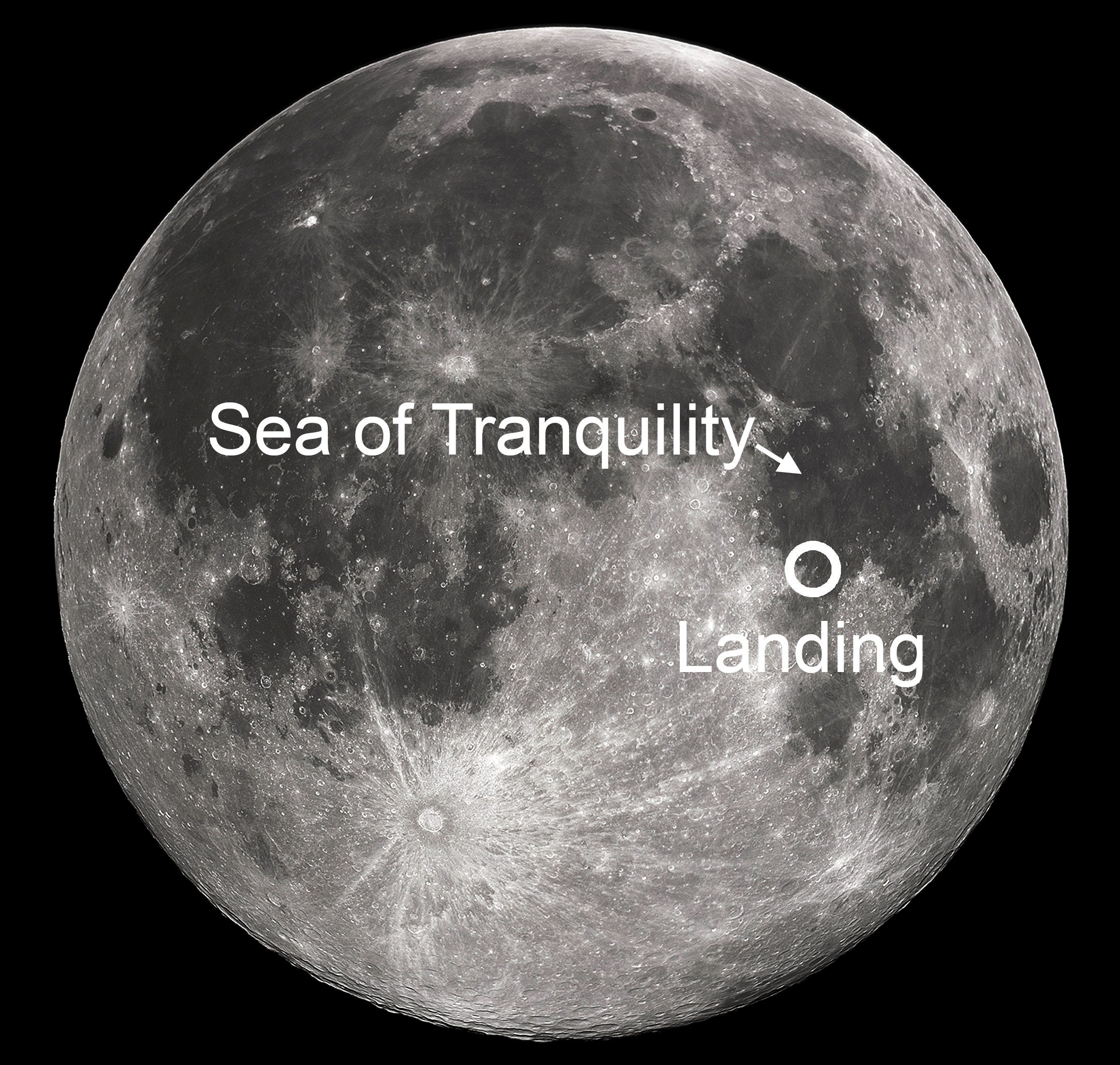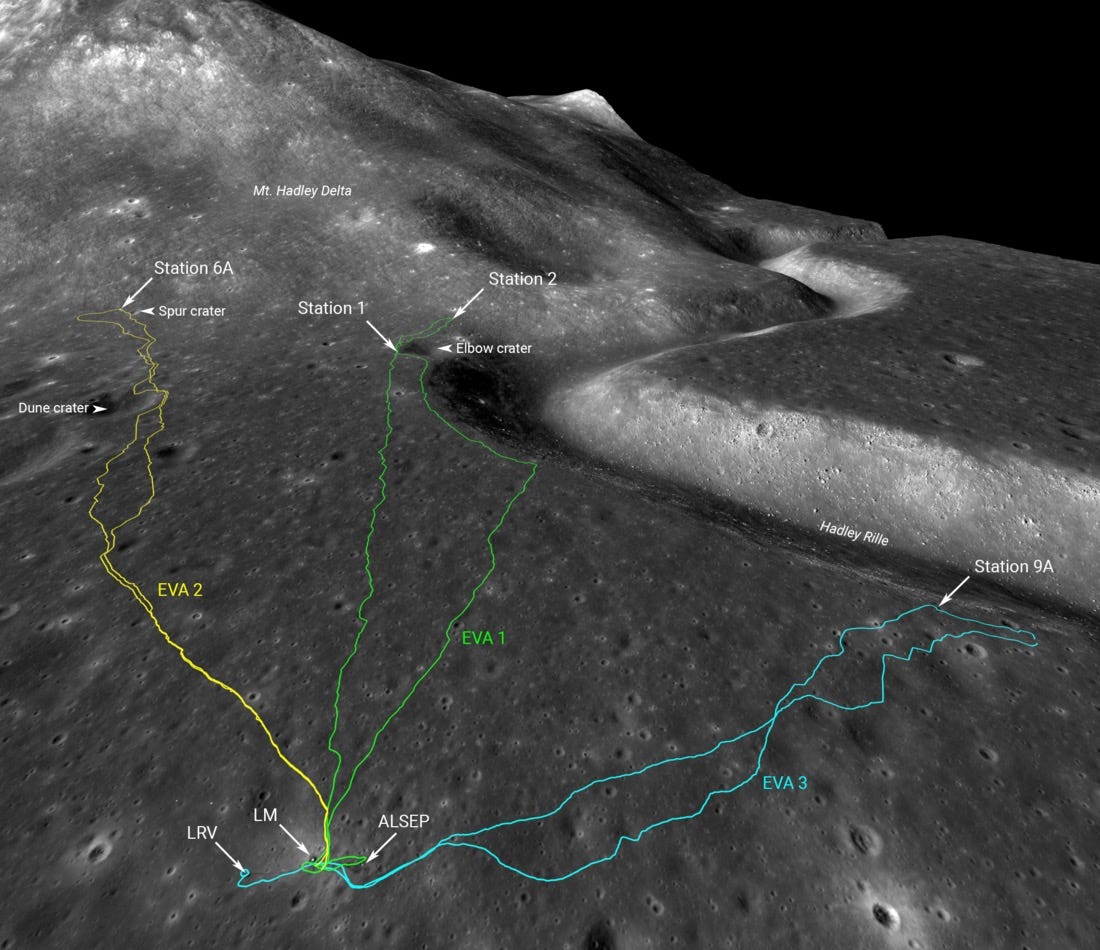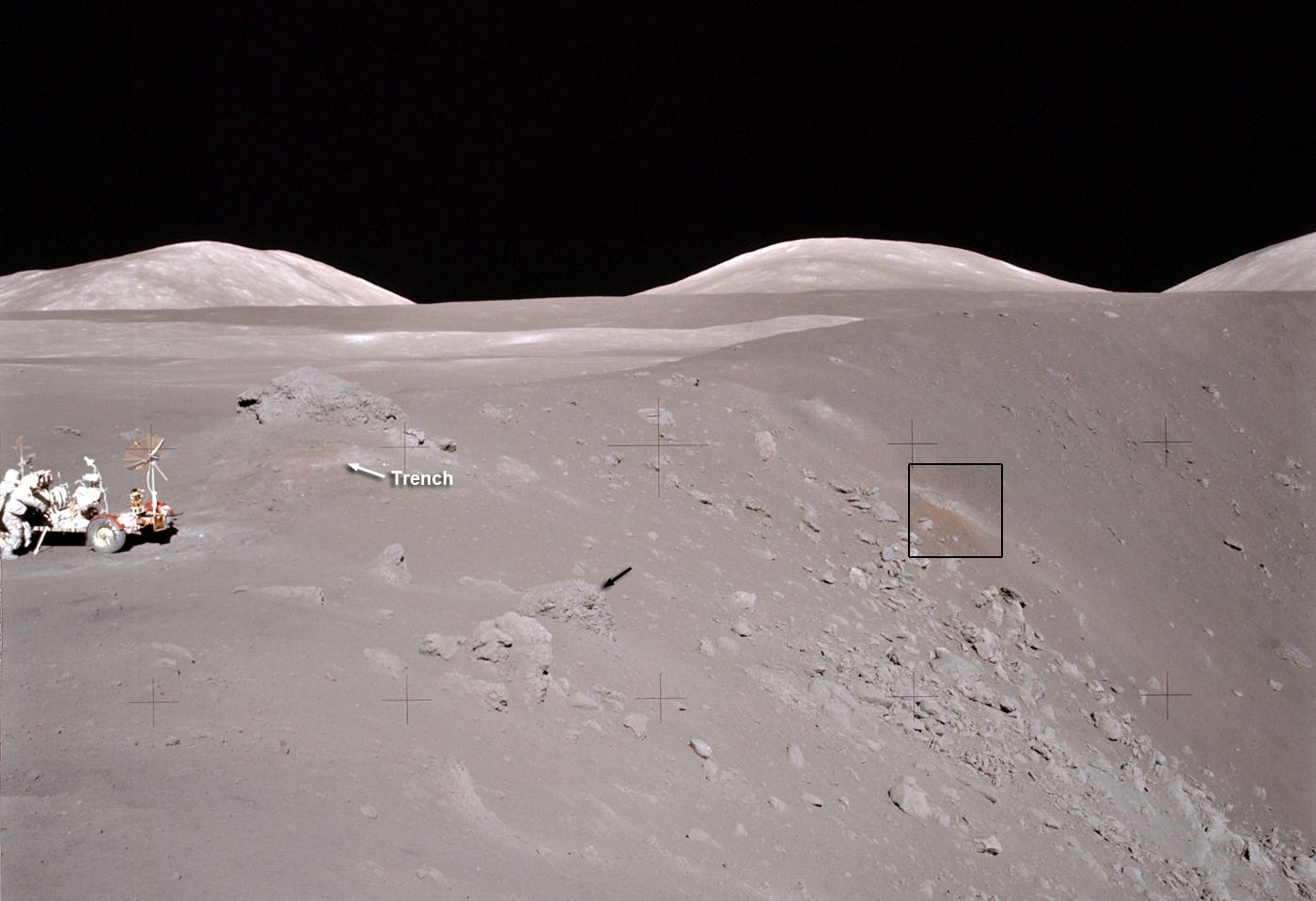Places on the Moon explored by Apollo astronauts and what we learnt from them
The geologically varied landing sites explored by NASA’s iconic human landing missions helped shape our understanding of the Moon.
Between 1969 to 1972, 12 astronauts walked on the Moon as part of NASA’s Apollo program. Each successful Apollo mission—11, 12, 14, 15, 16, and 17—visited a distinct feature of the Moon that would help us paint a more holistic picture of the Moon’s past. Here’s an overview of the geology of these sites and scientific facts learnt by exploring them.

Ancient lava plains for Apollo 11
NASA chose the first human landing mission to the Moon, Apollo 11, to touchdown within a plain, not-so-rocky region primarily for engineering simplicity. Nevertheless, the landing site was scientifically valuable.
When you look up to the Moon, you see several dark regions called mare areas. These are vast, solidified lava plains sitting on top of large, deep, ancient craters. The craters formed between 4.1 to 3.8 billion years ago during a time when large asteroids and comets were bombarding all planets and moons of the solar system. Later on, the Moon’s volcanoes filled those craters with lava which cooled over time to make the regions appear as they do today. Apollo 11’s landing region—the nearly 800 kilometers wide Mare Tranquillitatis—is one such giant lava-filled basin.

Apollo 11 collected 20 kilograms of rock and soil samples from near their landing site and brought them to Earth for detailed lab studies. Scientists found the soil to be basaltic, the most common rock type on Earth. Apollo 11 samples also contained tiny fragments of rocks thrown off by impacts on the nearby bright, rocky regions called highlands. These samples represent material from the Moon’s crust.
A different crust for Apollo 12
In November 1969, Apollo 12 landed within another mare region called Oceanus Procellarum. They touched down near the previously landed Surveyor 3 spacecraft to demonstrate precision landing, an ability crucial for future Apollo missions to navigate safely in challenging areas. Apollo 12 astronauts collected over 34 kilograms of samples from around the landing site.
Lab studies revealed that the lava here is slightly younger than at the Apollo 11 site, but still over 3.1 billion years old. Highland rocks thrown here by past impacts were different too, with one of the returned samples comprising significantly higher fractions of radioactive and rare-earth elements. This led scientists to realize that the Moon’s crust isn’t consistent throughout, as was long assumed, pointing to a richer history.
Impactful Apollo 14
With Apollo 14, NASA set out to determine the age of one of the largest ancient lunar craters, the thousand-plus-kilometer-wide Imbrium basin. But the mission didn’t land in the now lava-filled Imbrium for that, and instead touched down near a highland crater east of the Apollo 12 landing site. This site was chosen to collect rocks blasted out during Imbrium’s formation, and the astronauts brought about 43 kilograms of samples from the region.
Many of the site’s rocks were breccias, a complex mixture of broken and crushed rocks, as expected to form during the fierce impact that created Imbrium. Scientists learned by age dating these samples in labs that the Imbrium-impact occurred a little over 3.8 billion years ago.
Twists and turns for Apollo 15
Apollo 15 landed near the Hadley rille, an ancient lava channel formed 3.3 billion years ago when the Moon was volcanically active. Judging by the number of striking twists and turns in this 120 kilometers long channel, the lava flowing through it must be highly fluid. The Apollo 15 astronauts visited near the rille during the mission and photographed its walls. The images showed multiple layers, suggesting that the channel had experienced not one but many lava flows from multiple volcanic eruptions.

Out of the 77 kilograms of lunar samples Apollo 15 brought to Earth, one of them called the Genesis Rock represented ancient material that forms much of the Moon’s highlands. Age dating the sample in labs found it to be 4.1 billion years old, only about 300 million years younger than the Moon’s primordial crust.
Peering deeper with Apollo 16
Apollo 16 visited near the ancient Descartes crater within the lunar highlands. They measured unusually strong magnetic fields on the surface. Remnant magnetism in many of its samples suggests that the samples cooled in the presence of strong fields, alluding to a time when the Moon may have had a global magnetic field.
As with Apollo 14, most of the rocks turned out to be breccias. There were some ancient rocks similar to Apollo 15’s Genesis rock as well. Apollo 16 brought 95 kilograms of samples to Earth. Of them, sample 67215 is most peculiar because parts of it have an age of 4.46 billion years, almost going back to the formation of the Moon itself.

Volcanic landscapes for Apollo 17
The last Apollo mission landed near the edge of Mare Serenitatis in 1972. The various layers of ancient lava flows at the site indicated a volcanic period that lasted 700 million years. Among the most fascinating finds was orange volcanic soil, later dated to be 3.6 billion years old. It was among the 110 kilograms of samples the Apollo 17 astronauts brought to Earth.

Just as Apollo 14 dated Imbrium’s age using rocks blasted during its formation, Apollo 17 returned crustal rocks and breccias created and thrown away during the impact that formed the Serenitatis basin. Scientists determined that Serenitatis formed 3.9 billion years ago, right in the time range when large asteroids and comets were bombarding all the planets and moons in our solar system.
The Moon after Apollo
Apollo samples revealed that some of the Moon’s largest basins formed between 4.1 to 3.8 billion years ago, a (geologically) short period. This is how we even inferred that our solar system went through a heavy bombardment phase, something now widely accepted. With its experiments and 382 kilograms of samples brought to Earth, the Apollo missions revolutionized planetary science and helped paint our shared origin story with the Moon.
At the same time, Apollo’s scientific advances left us with more questions than answers. By visiting more and new types of locations on the Moon, particularly its poles, we can continue piecing together the complex origin and evolution of the Earth-Moon system as well as our solar system’s history. Here’s hoping that the renewed global frenzy of going to the Moon sticks around this time, as there are plenty of reasons to explore the Moon.
Thank you SWISSAPOLLO for supporting me and powering this article.
Like what you read? Support me to keep me going.
